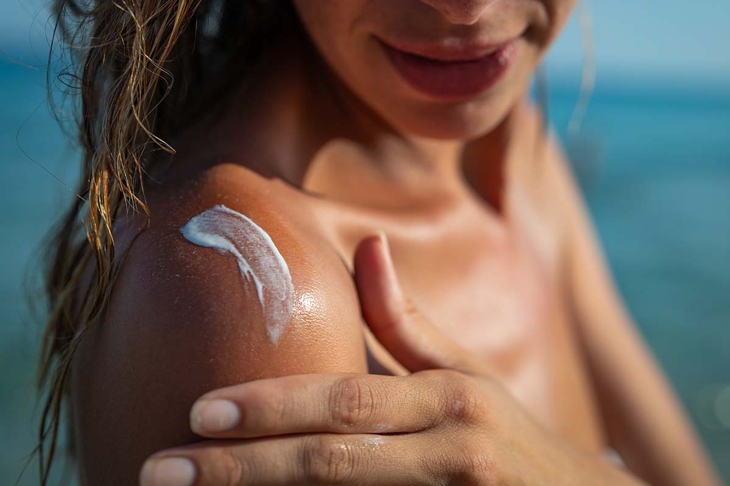SPF 30 and up

Sun protection factor (SPF) is an index of how well sunscreen prevents UV damage—and the most important consideration when choosing a sunscreen! Dermatologists recommend wearing SPF 30 or higher on all exposed areas of skin. Because most people underapply sunscreen, choosing a higher SPF is worthwhile. One study found that 27 percent fewer people suffered skin damage wearing SPF 100+ sunscreen compared to those wearing SPF 50+ during six hours in the sun.
Broad spectrum

The sun emits radiation at ultraviolet (UV) and visible wavelengths. Choosing a broad spectrum sunscreen is key to achieving well-rounded protection against UVB induced sunburns, as well as cancer-causing UVA and UVB rays. An added benefit of a natural, mineral-based sunscreens is their potential to protect against hyperpigmentation and other skin sensitivities triggered by visible light. The trick is to choose a natural sunscreen with a mineral-based tint to reflect visible light waves.
Environmental safety

Reduce your impact on the oceans, lakes, and rivers by choosing an environmentally safe sunscreen. The chemical UV filters oxybenzone, octocrylene, octinoxate, and ethylhexyl salicylate are now found in most waterways around the world—and affect the fish and coral reef ecosystems found there. These ingredients are so persistent that wastewater treatment plants often cannot remove them from the water, making it our responsibility to avoid using them.
Oxybenzone-free

Wearing sun protection should not mean sacrificing other aspects of heath! Some sunscreen chemicals, such as oxybenzone, are linked with changes to thyroid hormones, testosterone levels, and kidney function. Oxybenzone penetrates deep into the skin and can remain in the body for days after application. In one study, participants were discovered to have blood oxybenzone levels 500 times the regulated limit after just one application of sunscreen,.
Cream or stick form

Spray sunscreen can be fast to apply, but the air-borne particles are all too easy to breathe in.
The fine mist of an aerosol sunscreen can settle deep into your lungs. Even the mineral titanium dioxide used in natural sunscreens can become toxic when inhaled, leading to lung inflammation and cancerous cell growth. To protect your overall health (not just your skin), a cream or stick sunscreen is ideal.
Approved ratings

Choosing a sunscreen from an aisle that is chock-full of products can be overwhelming. To narrow your focus on the best options, look for a sunscreen that is approved by a reliable scientific body, such as the Environmental Working Group (EWG). The EWG’s 2021 sunscreen study analyzed 51 different products and discovered that on average, the UVA protection of sunscreen worked at only 25 percent of the labelled SPF.
Expiration date

There is a good reason that sunscreen sold in US and Canada is labelled with an expiration date. Sunscreen typically becomes unstable within three years of manufacturing—and faster when left out in the heat. Using expired sunscreen is considered unsafe and could leave you with unexpected sun damage. Make the most of your sunscreen purchase by checking its expiration date to confirm that you have at least a couple of years to use it.
Non-comedogenic

Protecting your skin from UV damage does not mean sacrificing clear pores. For acne sufferers, certain sunscreen ingredients can be irritating to the skin and trigger breakouts. Rather than do without (after all, sun exposure is a common trigger for acne), dermatologists recommend wearing a non-comedogenic sunscreen, which won’t block pores. A fragrance-free option is also a smart choice for anyone with sensitive skin.
Sunscreen only

A summer in the wilderness typically calls for both sunscreen and insect repellent. While 2-in-1 products can lighten your packing list, the Centers for Disease Control and Prevention recommends against them. Sunscreen is supposed to be reapplied every 2 hours, and in larger quantities than repellent, which could leave you overexpose to DEET, picaridin, or other repellent chemicals. Experts recommend applying a natural sunscreen first, followed by insect repellent when needed.
No retinyl palmitate

Retinyl palmitate is a controversial ingredient. This vitamin A derivative is often added to cosmetics for its antiaging benefits, but recent evidence suggests that it may speed up the development of cancer when used on sun-exposed skin. Studies show that combining retinyl palmitate with sunscreen is risky because the sun’s UVA rays break it down into byproducts that are damaging to the skin’s DNA.











